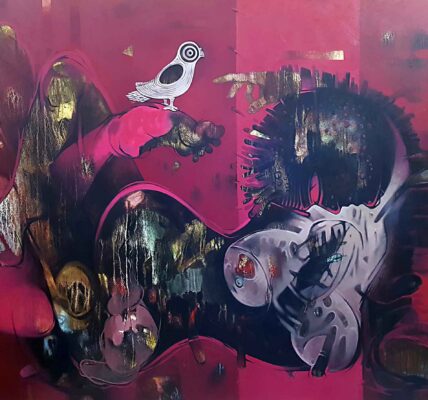
Nisha Aggarwal.
The world around us is generally discernible
by the placation of two opposite pylons, which
could be similar or opposite in nature but are
prevalent in every core of human life. Flipping
the crucial coin of nature versus progress,
artist Priyanka Govil presents a sub
polemic through her art work, reviews
REVIEW Delhi Nisha Aggarwal
Like a pendulum of a clock repeats its path between two limits, art
too has ranked between figuration and abstraction as a linguistic and
stylistic discourse, with semi-abstraction being agreeable to both. To
decipher the difference between the three and to discern the gradual
progressions from one to the other is as abstruse as trying to separate
one grain of sand.
A sense of analogical disparity prompted my visit to the solo show of
artist Priyanka Govil’s selected works at Art Bull, New Delhi presented
by gallery Art Konsult from 11th – 30th September, 2013. Delhi-based
Priyanka has obtained her BVA and MVA in Painting from Faculty of
Fine Arts, Maharaja Sayajirao University, Vadodara. She is the recipient
of Inlaks India Award 2010 and has had many solo, curated, as well
group shows in India to her credit.
Priyanka’s work could be seen as landscapes, including rivers,
roads, mountains etc. that one finds in nature or in the man-made
world around. In a few other works, the subtle subjective images kept in
created spacious backgrounds reveal the sublimity of natural scenes. But
interestingly, her works are mental projections of the images, objects,
architectures and natural scenes that she has collected in memory,
which emerge as landscapes. She replaces the natural elements with
mundane household objects in some places by merely suggesting their
presence. She rarely uses human figures, ironically, this stark absence
hints at the very presence of the human.
By using a borderline abstraction in her figuration, and replacing
natural with the manmade, Priyanka shows her concern for an
environment with fast depleting natural resources and the rapidly
changing landscape of today. The ghost-like presence of humankind
speaks of human interventions which has caused these changes not just
in natural landscapes, but cultural landscapes as well. Priyanka’s work
depicts the two faces of the coin of progress versus a fast-vanishing
environment.
In this collection, Priyanka has adopted a simply layered, textured
surface using dry mediums like charcoal and crayons, encouraging a
visual touching of the surface by the viewer. The effect is that of a woven
fabric which is highly textured. Priyanka’s palette toggles between
neutral browns, ochres, grays and black, interspersed with a use of a
sharp red which denotes a kind of danger in an otherwise mundane
mental landscape.
Priyanka’s art works display a symbiosis of tactility yet intangibility,
abstraction yet figuration, absence yet presence and deliberation yet
spontaneity. They are landscapes, but at the same time they are not
landscapes, they are made of minute strokes, but offer a wider image
of the artist’s imagination. They present the belongingness to various
opposite aspects which transcends from its something to its nothingness.
A visit to Priyanka’s show takes the viewer to the wake of an estuarine
coexistence

